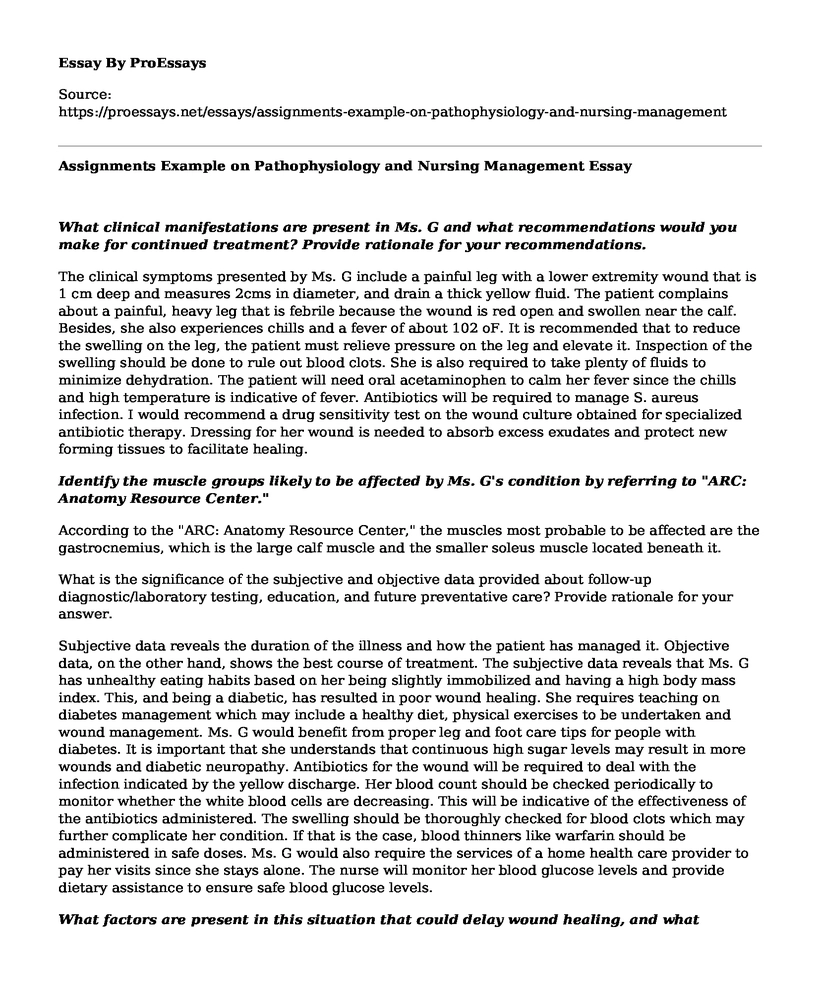What clinical manifestations are present in Ms. G and what recommendations would you make for continued treatment? Provide rationale for your recommendations.
The clinical symptoms presented by Ms. G include a painful leg with a lower extremity wound that is 1 cm deep and measures 2cms in diameter, and drain a thick yellow fluid. The patient complains about a painful, heavy leg that is febrile because the wound is red open and swollen near the calf. Besides, she also experiences chills and a fever of about 102 oF. It is recommended that to reduce the swelling on the leg, the patient must relieve pressure on the leg and elevate it. Inspection of the swelling should be done to rule out blood clots. She is also required to take plenty of fluids to minimize dehydration. The patient will need oral acetaminophen to calm her fever since the chills and high temperature is indicative of fever. Antibiotics will be required to manage S. aureus infection. I would recommend a drug sensitivity test on the wound culture obtained for specialized antibiotic therapy. Dressing for her wound is needed to absorb excess exudates and protect new forming tissues to facilitate healing.
Identify the muscle groups likely to be affected by Ms. G's condition by referring to "ARC: Anatomy Resource Center."
According to the "ARC: Anatomy Resource Center," the muscles most probable to be affected are the gastrocnemius, which is the large calf muscle and the smaller soleus muscle located beneath it.
What is the significance of the subjective and objective data provided about follow-up diagnostic/laboratory testing, education, and future preventative care? Provide rationale for your answer.
Subjective data reveals the duration of the illness and how the patient has managed it. Objective data, on the other hand, shows the best course of treatment. The subjective data reveals that Ms. G has unhealthy eating habits based on her being slightly immobilized and having a high body mass index. This, and being a diabetic, has resulted in poor wound healing. She requires teaching on diabetes management which may include a healthy diet, physical exercises to be undertaken and wound management. Ms. G would benefit from proper leg and foot care tips for people with diabetes. It is important that she understands that continuous high sugar levels may result in more wounds and diabetic neuropathy. Antibiotics for the wound will be required to deal with the infection indicated by the yellow discharge. Her blood count should be checked periodically to monitor whether the white blood cells are decreasing. This will be indicative of the effectiveness of the antibiotics administered. The swelling should be thoroughly checked for blood clots which may further complicate her condition. If that is the case, blood thinners like warfarin should be administered in safe doses. Ms. G would also require the services of a home health care provider to pay her visits since she stays alone. The nurse will monitor her blood glucose levels and provide dietary assistance to ensure safe blood glucose levels.
What factors are present in this situation that could delay wound healing, and what precautions are required to prevent delayed wound healing? Explain
One of the factors present in this situation that could delay wound healing is the poor maintenance of blood glucose levels. High blood glucose levels narrow the blood vessels, resulting in poor circulation. This impairs blood flow to the wound thereby reducing the flow of nutrients to the site. As a result, the white blood cell function is diminished, and thus wound healing is delayed. The impaired white blood cell functioning also leads to the low immune system, which explains the bacterial infection Ms. G acquired. The compromised immune system may cause nerve damage resulting in diabetic neuropathy. This may lead to increased ulcer development due to loss of sensation hence the patient may fail to notice an open wound. Initial management of the wound and the eating habits exhibited reveals that Ms. G lacks the necessary knowledge of diabetes-related self-care and dealing with the symptoms.
The following precautions should be taken. First, the patient should commit to maintaining the recommended blood glucose levels. This will require that Ms. G sticks to a healthy lifestyle with regards to diet and exercise. Not only will this lower her body mass index to a healthy level, but it will also decrease the risk for cardiovascular diseases. A balanced diet is mandatory in boosting her immune system. Vitamins are essential in manufacturing new white blood cells thereby increasing the body's defense against infections. Other foods such as pro-biotics and catechins have been shown to boost the immune system generally. Ms. G must also practice proper diabetics wound care to facilitate the healing. The appropriate dressing should be used on the wound to speed up the healing process. She should frequently check for possible wounds and signs of developing infections to enable rapid therapeutic response and minimize complications.
Cite this page
Assignments Example on Pathophysiology and Nursing Management. (2022, Jun 15). Retrieved from https://proessays.net/essays/assignments-example-on-pathophysiology-and-nursing-management
If you are the original author of this essay and no longer wish to have it published on the ProEssays website, please click below to request its removal:
- Managed Care - Healthcare Administration Major
- Medical Treatment of Uninsured Patients Essay
- Cardiovascular System and Its Response to Acute and Chronic Exercise Paper Example
- Patient Care Assistant Paper Example
- The Joys of Social Work: Giving Back to Society - Essay Sample
- Essay Example on Increase in Hookah Consumption: Early Exposure & Mythical Beliefs
- Lead Analyst's Challenge: Persuading Stakeholders With Data - Free Report Example







